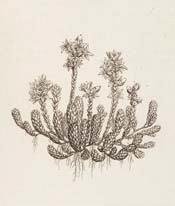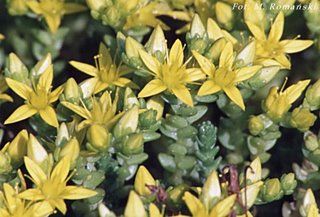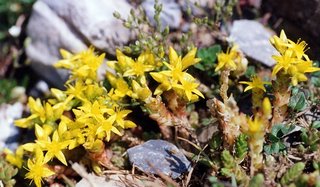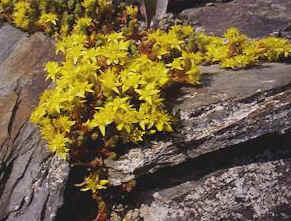Sedum acre (stonecrop, common)


Biting Stonecrop. Wallpepper. Golden Moss. Wall Ginger. Bird Bread. Prick Madam. Gold Chain. Creeping Tom. Mousetail. Jack-of-the-Buttery.
(French) Pain d'oiseau.
Part Used
Herb.
The Common or Biting Stonecrop is the commonest of the Stonecrops, growing freely upon walls and cottage roofs, on rocks and in sandy places, especially near the sea, forming tufts or cushions, 3 to 10 inches across, which in June and July are a mass of golden blossom, but its flowering season is very soon over.
The root is perennial and very fibrous, its minute threads penetrating into the smallest crevices. The stalks are numerous, many of them trailing and flowerless, others erect - generally 3 to 5 inches high - bearing the clusters of flowers. When growing among other foliage, or on rockwork, the flowerstalks are often drawn up to some height, at other times much dwarfed. They branch and are clothed with numerous leaves. The little upright and very succulent leaves that closely overlap on the flowerless stems are a distinguishing characteristic from the other yellowflowering species of Sedum; they are so fleshy as to be almost round. The starlike flowers are of a brilliant yellow colour, the five sepals small and inconspicuous, but the five petals, spreading and acutely pointed, are a striking feature. There are ten stamens, with anthers the same tint as the petals.
The pungency of the leaves has obtained for the plant its specific name of acre, and the popular English name of Wallpepper and Wall Ginger. Gerard tells us it was known in his day as Mousetail, or Jack of the Butterie. As regards the latter name, Dr. Fernie says: 'this and the Sedums album and reflexum were ingredients in a famous worm-expelling medicine or "theriac" (treacle), and "Jack of the Buttery" is a corruption of Bot. theriaque.'
De Lobel called it vermicularis, partly - we are told - from the grub-like shape of the leaves, and partly from its medical efficacy as a vermifuge.
- Some old writers considered this species to possess considerable virtues, but others, from the durability of its acrimony and the violence of its operation, have thought it unsafe to be administered. Culpepper tells us:
- 'Its qualities are directly opposite to the other Sedums, and more apt to raise inflammations than to cure them; it ought not to be put into any ointment, nor any other medicine.'
Pliny recommends it as a means of procuring sleep, for which purpose he says it must be wrapped in a black cloth and placed under the pillow of the patient, without his knowing it, otherwise it will not be effectual.



0 Comments:
Post a Comment
<< Home